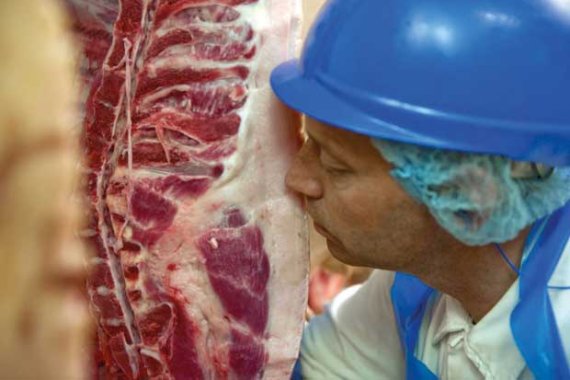This rapid improvement to animal welfare has not been brought about by government measures but by an alliance of animal welfare organizations, farmers, abattoirs and supermarkets, says former LEI researcher Gé Backus. Wageningen UR played a key role in the process. Backus led a research team which was asked five years ago to find an alternative to castration which would not affect the quality of the meat. The male porkers, or boars, used to be castrated preventively because otherwise their meat could give off a penetrating offensive smell when it was fried. Although the number of animals with this ‘boar taint’ is relatively small, the research assignment was a tough one because it is impossible to identify them in advance. Nevertheless, two years later the team had booked substantial successes. At the end of 2011, a survey among sow owners revealed that 43 percent of the boars were no longer castrated. That proportion has now been further increased to 75 percent. The 25 percent that are still being castrated are destined for the German market. Meat that is produced for the Dutch market is almost 100 percent castration-free, Backus estimates. Which is necessary in view of the ban on pork from castrated pigs to be imposed by the Dutch central office for the food trade, the Centraal Bureau Levensmiddelenhandel, in 2015.
The project got results fast, then. What were the crucial factors?
‘Five years ago the urgency was great, because there was a lot of pressure from organizations to improve animal welfare. In that context the animal protection society, farmers’ organizations, abattoirs and retailers got together and drew up the Noordwijk Declaration, to ban castration. The pork sector also allocated funding to the boar taint project, as did the government.’
How did the project contribute to the turnaround?
‘We made sure a constant stream of research results reached the steering committee. At first we met with scepticism along the lines of: you cannot guarantee the quality of the meat if you don’t castrate. That was a conviction based on more than 30 years of castrating. But with our stream of information you saw people’s ideas gradually changing: perhaps it was possible after all.’
What was the crucial turning point?
‘When the supermarkets accepted the meat from boars. The supermarkets wanted to be sure consumers would not be put off by meat that could give off boar taint, and they wanted a reliable system for detecting boar taint at the abattoir. When consumer researchers, psychologists and tests for detecting boar taint could demonstrate that these things would not cause problems, they changed their minds. The consumer issue is the crucial one, and we can see that internationally too. The German supermarkets, an important market for our pork farmers, haven’t got that far yet because they are scared of incidents and a drop in consumer confidence. So Germany does not yet accept meat from castrated pigs.’
How is boar taint detected?
‘The unpleasant smell (and the taste that goes with it) is largely caused by two substances, skatole and androstenone. In four percent of boars, concentrations of these substances are too high. We have researched whether we can get rid of these substances through breeding. We’ve had partial success with that: instead of 4 percent stinkers, we now end up with fewer than 2 percent. To track those down, we first thought in terms of an electronic nose which could measure skatole and androstenone, but that proved too ambitious. The human nose still works best. So there are trained assessors in the abattoir, who heat a piece of the carcass with a soldering iron and smell it. The meat is given a boar taint score of between 0 and 4. Meat with a high score is taken out of the production line. We have noticed that the accuracy varies per nose.’
The market demands 75 percent uncastrated meat, while the Dutch food sector demands 100 percent. What is the next step?
‘The Dutch pork sector is ahead of the game and is now dependent on international developments. In 2011 a declaration was drawn up at EU level with the aim of ending castration by 2018. The sense of urgency varies from country to country. Especially in southern European countries like Italy, animal welfare is not a big issue. In Germany it’s the supermarket’s call. They could bring about a fast change.’

